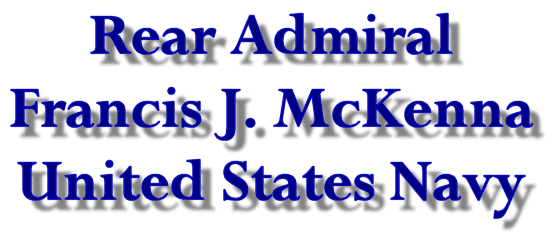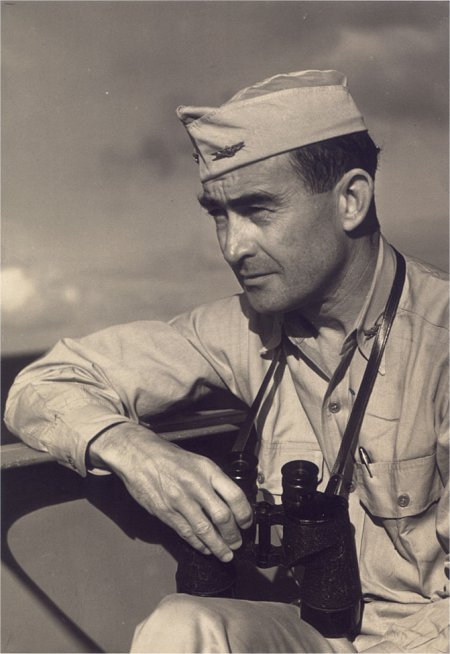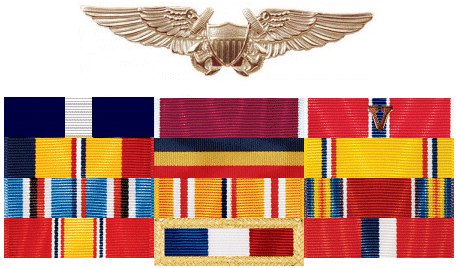
Commanding Officer
USS SAINT LO (CVE 63)

U.S. Navy photograph
Captain Francis Joseph McKenna, U.S. Navy
On the Midway's bridge in May 1944 prior to their baptism of fire in the Marianas campaign in June '44

| Navy Cross | |
| Legion of Merit | |
| Bronze Star with Combat V | |
| Combat Action Ribbon | |
| Presidential Unit Citation | |
| American Defense Service Medal | |
| American Campaign Medal | |
| Asiatic-Pacific Campaign Medal | |
| World War II Victory Medal | |
| National Defense Service Medal | |
| Philippine Presidential Unit Citation | |
| Philippine Liberation Medal | |
| Award Criteria | |
| RANK | DATES | DUTY STATION/EVENT |
| - | 1898 | Born in Leicester, Massachusetts |
| MIDN | 1917-1920 | Midshipman, United States Naval Academy |
| ENS | 1920-1921 | USS NORTH DAKOTA (BB-29) |
| ENS | 1921-1923 | USS SACRAMENTO (PG-19) |
| ENS | 1923-1924 | USS ELCANO (PG-38) |
| ENS | 1925 | USS JOHN D. EDWARDS (DD-216) |
| LTJG | 1925-1926 | Student at Naval Air Station, Pensacola, Florida |
| LTJG | 1926-1927 | Scouting Squadron VS-1 |
| LTJG | 1927 | Torpedo Plane Pilot on LEXINGTON (CV-2) |
| LTJG | 1928 | Fighting Three (VF-3) on LEXINGTON (CV-2) |
| LT | 1929 | Fighting Five (VF-5) on LEXINGTON (CV-2) |
| LT | 1929-1931 | Flight Instructor at Naval Air Station, Norfolk, Virginia |
| LT | 1932-1934 | Patrol Squadron Ten (VP-10) |
| LT | 1935-1937 | OIC, Experimental Department, at Naval Air Station, Norfolk, Virginia |
| LCDR | 1937-1938 | CO, Bombing Squadron 6 (VB-6) on ENTERPRISE (CV-6) |
| LCDR | 1939-1940 | Tactics Officer at Commander, Aircraft, Battle Force |
| CDR | 1940-1942 | Operations Officer at Naval Air Station, Norfolk, Virginia |
| CDR | 1942 | CO, Naval Air Station, Dutch Harbor |
| CAPT | 1942 | Commander, Unalaska Subsector |
| CAPT | 1942 | Commandant of the Naval Operating Base, Dutch Harbor |
| CAPT | 1943-1944 | PCO/CO, USS MIDWAY (CVE-63) |
| CAPT | 1944 | CO, USS MIDWAY (CVE-63) at Saipan, Tinian, and Morotai |
| CAPT | 1944 | CO, USS ST LO (CVE-63) at Samar |
| CAPT | 1945 | CO, Naval Air Station, Sand Point, Seattle, Washington |
| CAPT | 1945-1947 | PCO/CO USS KEARSARGE (CV-33) |
| CAPT | 1947-1948 | CO, Naval Air Station, Corpus Christi, Texas |
| CAPT | 1949-1950 | Bureau of Aeronautics, Representative to Grumman Aircraft Engineering Corporation |
| RADM | 1950 | Retired from Service |
| - | 1950-1961 | Consultant, Grumman Aircraft Engineering Corporation |
| - | 1969 | Died |
Short biography of
Rear Admiral Francis Joseph McKenna, U.S. Navy
by Michael F. McKenna
Rear Admiral Francis Joseph McKenna was born on March 19th, 1898 at Leicester, Massachusetts. He received his early education at the Leicester Grammar School, the Leicester Academy (1912-14), the Worcester Boys’ Trade School (1914-15), and St John’s High School, Worcester from 1915-17.
In 1917, he was appointed to the United States Naval Academy with the class of 1921. Because of the need for more naval officers during the First World War, the Class of 1921 was divided into two parts, ’21A (which graduated one year early) and ’21B (which graduated in 1921.) Midshipman McKenna graduated with the top half of his class in 1920 and reported on board the battleship USS North Dakota (BB-29). He spent a year and a half there before transferring to the gunboat USS Sacramento (PG-19), a unit of the Special Service Squadron which visited Vladivostok after the Russian Revolution.
After two years’ duty with the Special Service and the Asiatic Squadrons, Ensign McKenna was reassigned as Gunnery Officer on the 42-year old (launched 1881 by Spaniards) gunboat USS Elcano (PG-38), where he spent just under two years on Yangtze Patrol. (The Elcano was similar to the fictional USS San Pablo, the gunboat in the Steve McQueen movie “The Sand Pebbles.) In January 1925, Ensign McKenna reported to the USS John D. Edwards (DD-216), a destroyer serving on Asiatic Station.
After eight months aboard the Edwards, in August 1925, his application for flight training was approved and, upon the return of the Edwards to the United States, he reported to the Naval Air Station at Pensacola, Florida.
Upon successful completion of flight training in April of 1926, Lieutenant (junior grade) McKenna was awarded his Navy Wings and reported as a pilot in Scouting Squadron 1 (VS-1) of the Scouting Fleet, where he remained for about one year.
In 1927, he became a torpedo plane pilot on first cruise of USS Lexington, the newest aircraft carrier to join the Fleet. It was during this time that he met and married Catherine Eldredge (Cheatham) Bagnall, the widow of his classmate from ‘21B, Marine 1st Lieutenant Roger S. Bagnall. Subsequent sea-going flying assignments followed during the next two years with Fighting Three (VF-3) and Fighting Five (VF-5) on board Lexington.
In 1929, Lieutenant McKenna was assigned to three years of shore duty at Naval Air Station, Norfolk, Virginia as a Flight Instructor with the Experimental Department. It was during this time that he supervised and took part in the testing of the new, hydraulic arresting gear (invented by Vice Admiral Mel Pride) that revolutionized carrier operations.
In 1932, he began a three-year tour with Patrol Squadron Ten (VP-10), based variously in Norfolk, Virginia; Coco Solo, Panama; San Diego, California; and Honolulu, Hawaii. In 1935, he returned to the Naval Air Station at Norfolk where he became the Officer-in-Charge of the Experimental Department. In 1937, Lieutenant Commander McKenna became the first Commanding Officer of Bombing Squadron 6 (VB-6) assigned to the brand-new carrier USS Enterprise (CV-6). Under Commander McKenna’s leadership, Bombing Six proved the value of the Navy’s first all-metal, mono-wing dive bomber, the Northrop BT-1—the direct predecessor of the famous Douglas Dauntless (SBD). (Nine years later, Bombing Six, flying the SBD Dauntless, was a major participant in the crucial Battle of Midway in June of 1942, when it was responsible for the sinking of the Japanese aircraft carriers Kaga and Akagi.)
From 1939 to mid-1940, Lieutenant Commander McKenna served one-year tour as Tactics Officer on the staff of (then) Rear Admiral Earnest J. King, Commander, Aircraft, Battle Force.
From June 1940 until June 1942, he served as Operations Officer at the Naval Air Station, Norfolk, Virginia. With the war with Japan underway, he was promoted to Commander and ordered to duty as Commanding Officer of the Naval Air Station at Dutch Harbor, in the Aleutian Islands. Shortly after his arrival there, he was promoted to the rank of Captain and assigned additional duty as Commander, Unalaska Subsector and Commandant of the Naval Operating Base, Dutch Harbor and. This placed him in command of all US Navy forces operating in the Aleutian Islands.
In the spring of 1943, he was ordered as the Prospective Commanding Officer of the escort carrier USS Midway, then under construction at the Kaiser Shipbuilding Company in Vancouver, Washington.
Captain McKenna placed the ship in commission on the 23rd of October 1943. Midway ferried replacement aircraft to Hawaii and Australia, and operated from San Diego and Pearl Harbor training aviators from newly-formed composite aircraft squadrons until April 1944, when Composite Squadron 65 (VC-65) was embarked. In June and July 1944, Midway was in action in support of amphibious operations against the islands of Saipan and Tinian, and in early October, took part in support operations during the invasion of Morotai. On the 10th of October 1944, the ship was renamed Saint Lo, thereby freeing the name Midway for a super carrier then under construction.
St. Lo was a member of “Taffy 3” at the Battle of Leyte Gulf, the largest naval battle in history. The ship came through the surface engagement with the Japanese battle fleet unscathed, but shortly afterwards was attacked by a kamikaze aircraft of the Shikishima Special Attack unit and was sunk, the first US ship to be sunk by a Japanese suicide attack. Captain McKenna, the last man to leave his doomed ship, was awarded the Navy Cross for conspicuous gallantry in action.
After the post-sinking affairs were completed, Captain McKenna was assigned as Commanding Officer of the Naval Air Station at Sand Point, Seattle, Washington.
In July, 1945, Captain McKenna was ordered to the assignment he had always longed for: Commanding Officer of an Essex class aircraft carrier, then under construction at the Brooklyn Navy Yard. USS Kearsarge (CV-33) was placed in commission by Captain McKenna on March 2, 1946. Much to his chagrin, his new ship was completed too late to participate in the final operations against Japan.
Following detachment from Kearsarge in 1947, Captain McKenna was assigned as the Commanding Officer of the giant Naval Air Station complex at Corpus Christi, Texas.
His final active duty assignment was as the Bureau of Aeronautics Representative to the famed “Grumman Iron Works” (Grumman Aircraft Engineering Company) where he renewed his friendships with Roy Grumman and the other pioneers of Naval Aviation with whom he had worked over a 30-year career, during which he accumulated 3,750 military flight hours. Upon his retirement in 1950, he was promoted to the rank of Rear Admiral.
Admiral McKenna was authorized to wear the Navy Cross (second only to the Medal of Honor), the Bronze Star with Combat “V,” and the Legion of Merit medals. Additionally, and of great pride to him, he was authorized—with the rest of the crew of USS St. Lo (CVE-63)—to wear the Presidential Unit Citation for the heroic and magnificent job performed by ship and men at Leyte Gulf as a unit of “Taffy 3” (TU 77.4.3).
Following his retirement from the Navy in 1950, Admiral McKenna worked as a full-time, and later a part-time, consultant to the Grumman Aircraft Engineering Corporation, until retiring for good in 1961. He and his family resided in Manhasset, New York from 1948 until his death from cancer on 29 May, 1969. Admiral McKenna was survived by his wife, Catherine, who died in January 1981, his stepson Roger S. Bagnall III of New Jersey, who died in July 2008, his daughter Elizabeth, who died in 1986, and his son Michael, who resides in Rhode Island.
Source: The Admiral's son, Michael F. McKenna.